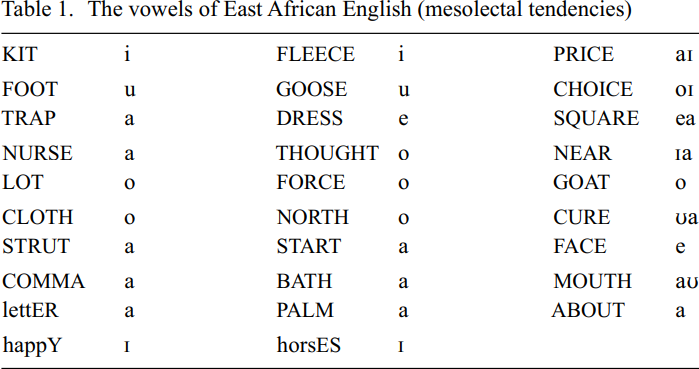


 Grammar
Grammar
 Tenses
Tenses
 Present
Present
 Past
Past
 Future
Future
 Parts Of Speech
Parts Of Speech
 Nouns
Nouns
 Verbs
Verbs
 Adverbs
Adverbs
 Adjectives
Adjectives
 Pronouns
Pronouns
 Pre Position
Pre Position
 Preposition by function
Preposition by function 
 Preposition by construction
Preposition by construction
 Conjunctions
Conjunctions
 Interjections
Interjections
 Grammar Rules
Grammar Rules
 Linguistics
Linguistics
 Semantics
Semantics
 Pragmatics
Pragmatics
 Reading Comprehension
Reading Comprehension|
Read More
Date: 2024-06-25
Date: 2024-03-25
Date: 2024-03-26
|
A comparison of the English phoneme system with that of most African languages shows that the major difference are not the consonants but the few vowel contrasts compared to the extensive English vowel system. Thus the vowel system of EAfE deviates systematically, vowels tend to merge, because the extreme range of the English vowel continuum is not covered by the underlying African systems of, for instance, the Bantu languages. On the whole three basic generalizations may be made for English vowels:
(a) Length differences in vowels are levelled and not used phonemically; thus FLEECE and KIT, GOOSE and FOOT, THOUGHT and NORTH, and BATH, STRUT and TRAP tend to merge. This is not only a quantitative, but also a qualitative shift, as usually short vowels in EAfE are longer and more peripheral than in RP, especially /ɪ/ tends towards /i'/ , /ʊ/ towards /u'/ , /ɔ/ towards /o'/ and /Λ/ and /æ/ towards /a'/.
(b) The central vowels of STRUT, NURSE and lettER, are avoided and tend towards half-open or open positions of BATH and, less often, DRESS. This conforms to the tendency towards more extreme articulatory positions of the tongue in general. It leads (together with the syllable-timing, to the phenomenon that, whereas vowels in full syllables tend to be underdifferentiated, those in unstressed ones may be overdifferentiated. Hence the difference between policeman and policemen or between the suffixes -ance and -ence may be clearer than in Standard English.
(c) Diphthongs tend to have only marginal status and to be monophthongized. In the short closing diphthongs MOUTH and particularly FACE the second element is hardly heard in many African varieties (as in Scotland; thus coinciding almost with the DRESS vowel). Diphthongs with a longer glide are preserved, but they are not really pronounced as falling diphthongs, i.e. with less emphasis on the second element than on the first, but rather as double monophthongs (e.g. [oɪ] , [aʊ]). All the centring diphthongs (NEAR, SQUARE, CURE) tend to be pronounced as opening diphthongs or double monophthongs ( [ɪa, ea, ua] ; cf. tendency (b) above).
These general observations on vowel pronunciation seem to hold for so many African varieties that this cannot be interpreted merely as a product of mother-tongue interference. In fact, some of these features of “Africanization” have already been predicted by Gimson (1980: 306) in very general terms, i.e. without any reference to Africa, because of the particularly complex structure of the English vowel system:
… the full systems [20 vowels and 24 consonants] must be regarded as complex compared with the systems of many other languages. In particular, the opposition of the close vowels /i:/-/i/, /u:/-/u/, the existence of a central long vowel /з:/ and the delicately differentiated front vowel set of /i:/-/i/-/e/-/æ/ + /Λ/ , together with the significant or conditioned variations of vowel length, will pose problems to many foreign learners.
Finally, it is worth considering the vowel system as a whole (in terms of Wells 1982). In contrast to West African varieties, which tend towards a basic seven-vowel system, East African varieties tend towards a basic five-vowel system (Table 1).

An interesting single parameter in this respect is the deviation of the RP long central NURSE vowel: it tends toward a back vowel /ɔ/ in West African varieties, towards a front vowel /a/ in Eastern and towards /e/ Southern African varieties, but these tendencies are not uniform in a region, neither across all ethnic groups, nor across the lexicon, as in Tanzania girl tends towards front (DRESS) and turn towards back pronunciation (START) because of spelling pronunciation.
|
|
|
|
تفوقت في الاختبار على الجميع.. فاكهة "خارقة" في عالم التغذية
|
|
|
|
|
|
|
أمين عام أوبك: النفط الخام والغاز الطبيعي "هبة من الله"
|
|
|
|
|
|
|
قسم شؤون المعارف ينظم دورة عن آليات عمل الفهارس الفنية للموسوعات والكتب لملاكاته
|
|
|